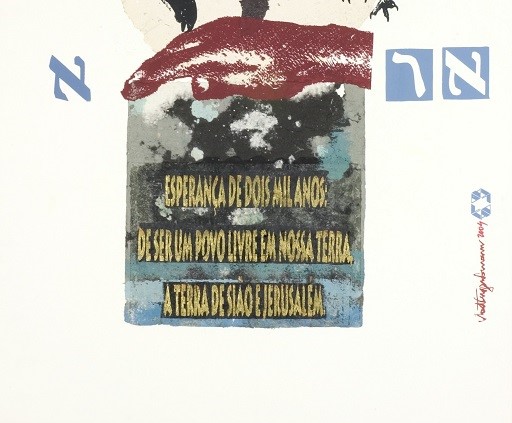Rainha Vashti
uma “feminista” na Antiguidade
DOI:
https://doi.org/10.35699/1982-3053.2023.46513Palavras-chave:
Rainha Vashti, Rainha Ester, FeministasResumo
A história da rainha Ester, contada no texto Livro de Ester, conseguiu ser rainha após a rainha Vashti, até então esposa do rei Ahasuerus, se negar dançar e a se expor para todos os homens de todas as cidades do império Persa, afrontando o status quo masculino e machista em relação ao corpo da mulher como objeto de exposição e exibição. A metodologia usada é de revisão de literatura e de sites judaicos sobre a temática das rainhas Vashi e Ester. Trata de uma narrativa de uma judia exilada na Pérsia e viveu durante o período de reinado de Ahasuerus, também conhecido como Assuero (Xerxes) entre 486 e 465 a.e.c (antes da era comum), e que se entende que a judia Ester agregou hábitos não judaicos em todos os aspectos da sua vida judaica como rainha casada com um rei não judeu do Império Persa.
Downloads
Referências
AKINYELE, Olufunmilayo O. Queen Esther as a servant leader in Esther 5:1-8.
Journal of Biblical Perspectives in Leadership. v.2, n.2, 51-79, 2009.
AMSELLEM, Wendy. Vashtiand Esther: A Feminist Perspective The relationship
between he two Persian queens is integral to under standing the Purim story. My
Jewish Learning, 2023. Disponível em:
https://www.myjewishlearning.com/article/vashti-esther-a-feminist-perspective.
Acesso em: 22 mar. 2023.
BUTLER, Judith. Problemas de gênero: feminismo e subversão de identidade. Rio de
Janeiro: Civilização brasileira, 2003.
CRAWFORD, Sidnie White. Vashti: Bible. Jewish Women's Archive, 23 jan. 2021.
Disponível em: https://jwa.org/encyclopedia/article/vashti-bible. Acesso em: 23 mar.
CYFER, Ingrid. Feminismo, identidade e exclusão política em Judith Butler e Nancy
Fraser. Idéias. Campinas, v.8, n. 1, p. 247-274, 2017.
FEMENÍAS, María Luisa. A crítica de Judith Butler a Simone de Beauvoir. Sapere
Aude. Belo Horizonte, v.3, n.6, p.310-339, 2012.
GABRIEL, Ruan de Sousa. União Soviética foi pioneira nos direitos das mulheres, diz
historiadora. Época, mai. 2014. Disponível em:
mar. 2023.
GIL, Antonio Carlos. Como elaborar projetos de pesquisa. 5. ed. São Paulo: Atlas, 2010.
GINSBERG, Alan Robert. Breaking Free of the Esther/Vashti Complex. Jewish Journal,
mar. 2019. Disponível em:
https://jewishjournal.com/commentary/analysis/295455/breaking-free-of-the-esthervashti-complex. Acesso em 23 mar. 2023.
HOLLANDA, Heloísa Buarque de (org.). Pensamento feminista: conceitos
fundamentais. Rio de Janeiro: Bazar do Tempo, 2019.
HULER, Scott. Queen Esther is a Jewish hero, but Queen Vashti is the feminist icon
we need right now. Forward Independent Nonprofit, 16 mar. 2022. Disponível em:
https://forward.com/opinion/484117/queen-esther-is-a-jewish-hero-but-queen-vashtiis-a-feminist-icon. Acesso em: 22 mar. 2023.
LARKIN, Jane. What Would Esther Think? Jane Larkin. 18 doors, 2023. Disponível
em: https://18doors.org/what-would-esther-think. Acesso em: 23 mar. 2023.
MADERER, RABBI JILL L. Vashtiis Now: Accountability in the Reform
Movementand in Our Communities. Women of Reform Judaism, mar. 2023. Disponível
em: https://wrj.org/blog/vashti-now-accountability-reform-movement-and-ourcommunities. Acesso em 23 mar. 2023.
MARCONI, MA; LAKATOS, EM. Fundamentos de metodologia científica. São Paulo:
Atlas, 2016.
MARTINS, Geiza. Conheça 15 mulheres feministas que fizeram história. UOL, abr.
Disponível em:
<https://www.uol.com.br/universa/noticias/redacao/2018/04/24/conheca-15-
mulheres-feministas-que-marcaram-a-historia.htm>. Acesso em: 23 mar. 2023.
MEGUILAT Ester Inteira. Chabad, 2023. Disponível em:
https://pt.chabad.org/library/article_cdo/aid/1090135/jewish/Meguilat-EsterInteira.htm. Acesso em: Acesso em: 22 mar. 2023.
NICHOLS, Clarina I. H.; GAMBONE, Joseph G. The Forgotten Feminist of Kansas, 5.
Kansas State Historical Society, Spring, v.40, n.1, p. 72-135, 1974. Acesso em: 22 mar.
NOVINSKY, Anita. Os judeus que construíram o Brasil: fontes inéditas para uma nova
visão da história. São Paulo: Planeta, 2015.
PINTO, Céli Regina Jardim. Feminismo, história e poder Revista de Sociologia e
Política. Curitiba, v. 18, n. 36, p. 15-23, 2010.
PORCHAT, Patrícia. Um corpo para Judith Butler. Periódicus. Salvador, n. 3, v. 1,
REICH, Hannah. Vashti: Judaism's first feminist bad girl. ABC, RN, 4 Set 2016.
Disponível em: https://www.abc.net.au/radionational/programs/earshot/vashtijudaisms-first-feminist-bad-girl/7809508. Acesso em: 23 mar. 2023.
RUTH. Tanakh. Serafia 2023. Disponível em:
https://www.sefaria.org/Ruth?tab=contents. Acesso em: 23 mar. 2023.
SCHIZER, Josephine. Vashti & Esther: Two Models of Feminism. Jewish Telegraphic
Agency, fev. 2018. Disponível em: https://www.jta.org/2018/02/28/ny/vashti-esthertwo-models-of-feminism. Acesso em: 22 mar. 2023.
SEVERINO, Antônio Joaquim. Metodologia do trabalho científico. 2. ed. São Paulo:
Cortez, 2017.
SHENHAR, Aliza. Vashti: The first feminist. Jerusalem Post, mar. 2015. Disponível em:
https://www.jpost.com/not-just-news/vashti-the-first-feminist-392905. Acesso em: 22
mar. 2023.
TREATMAN, Ronit. Queen Esther: Patron saint of crypto-Jews: faced with threat of
execution for Jewish observance, Sephardi conversos createdthe festival of Santa
Estericatore place Purim. The Times of Israel, mar. 2014. Disponível em:
%20Ahasuerus. Acesso em: 23 mar. 2023.
TUCKMAN, Vicki. Vashti: Finding a Feisty Feminist in ourb Purim Story. Reform
Judaism, fev. 2013. Disponível em: https://reformjudaism.org/blog/vashti-findingfeisty-feminist-our-purim-story. Acesso em: 22 mar. 2023.
YIN, Robert K. Pesquisa qualitativa do início ao fim. Tradução de Daniel Bueno. Porto
Alegre: Penso, 2016.
Downloads
Publicado
Edição
Seção
Licença
Copyright (c) 2023 Arquivo Maaravi: Revista Digital de Estudos Judaicos da UFMG

Este trabalho está licenciado sob uma licença Creative Commons Attribution 4.0 International License.
Os direitos autorais pertencem exclusivamente aos autores. Os direitos de licenciamento utilizados pelo periódico é a licença Creative Commons Attribution 4.0 (CC BY 4.0): são permitidos o compartilhamento (cópia e distribuição do material em qualquer meio ou formato) e adaptação (remix, transformação e criação de material a partir do conteúdo assim licenciado para quaisquer fins, inclusive comerciais.






